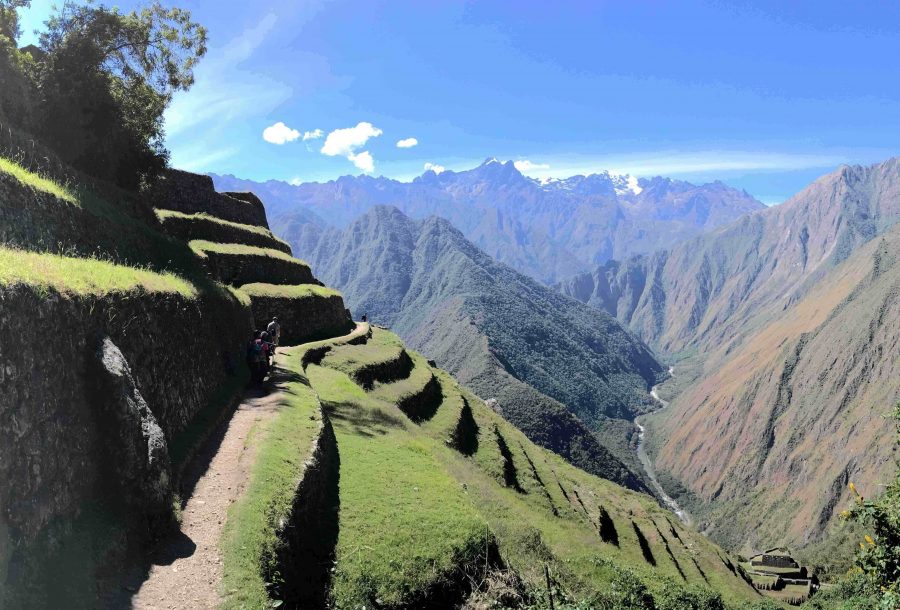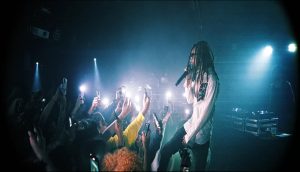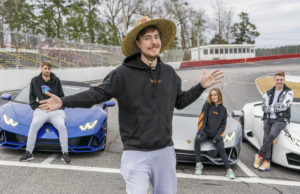Hiking on the Inca Trail
The view from the site of an Inca ruin along the trail. This picture was taken on the first day of the hike.
July 19, 2016
Almost immediately after school ended, my family and I were on our way to South America for a 10 day trip. The main purpose for our visit was to go to Peru and embark on a four day, three night hike on the Inca Trail. Before the trip I had gone hiking on multiple trails at both Harper’s Ferry and Bull Run Mountain. To me, Bull Run was fairly easy, and I was able to comfortably hike for two hours with a moderately heavy backpack on my back. Most of the trails at Harper’s Ferry were the same level of difficult. However, one of the trails at Harper’s Ferry, Loudoun Heights, was slightly more difficult than the rest. What made this trail tough? The approximately ten minutes of steep-ish uphill. After these hikes, I always felt prepared for the Inca Trail, I just assumed it would be slightly harder because I would be hiking for a longer period of time. I couldn’t have been more wrong.
Day One: In my opinion, the first day was the easiest, and the hardest part of my day was probably waking up at four AM to get ready for the two hour bus ride up the mountain to the starting point of our hike. After the bus ride, my group, which consisted of me, my parents, my brother, and two friends from Boston whom we didn’t know before, had the opportunity to have breakfast in a local restaurant. This was around seven AM, and that was probably the coldest I have ever been in my life. I had foolishly assumed it would warm up by the time we got off the bus, so I hadn’t worn all my layers. I was only wearing leggings, a long-sleeved t-shirt, and a sweatshirt on top of that. Since I was so cold, I decided to put on a few more layers and wore my hiking pants over my leggings and another jacket on top of my sweatshirt. This was definitely a mistake because once we had hiked for an hour or two, it felt like the temperature had gone up by 50 degrees, and I had to take off the extra layers I had put on.
Apart from the temperature, the hike itself was not too difficult. The first day is when you see the most people, as many locals live along the trail. However, there is a lot of poop from horses and donkeys on the trail because the locals (also known as the Highlanders) use them to get from place to place and transport goods they sell along the trail. It’s quite funny to see the Highlanders walking up the trail as if it’s a casual stroll while you’re sweating and panting. The trail on the first day was what my tour guide called “Inca flat”, which mean it had five to ten minute uphill and downhills scattered along the way.
The lunch on the first day was definitely the most shocking. Since my group was hiking as part of a tour, meals and tents were provided by the tour company. Our lunch on the first day included a local delicacy, guinea pig. According to my guide, the Incas domesticated the guinea pig and would eat them regularly. Guinea pig is like a drier, more gamey version of chicken, and isn’t horrible overall.
Once I reached the base camp on the first day, I was feeling pretty good, and I got a good night’s sleep after a good dinner. Before dinner we had a ceremony where our tour guide introduced us to the porters. On the trail, you only have to carry your day pack which has your layers, some snacks, water, and anything else you would need along the trail, and it’s around five pounds. The porters carry everything else, the tent, the sleeping bags, the food, etc., and they carry almost seventy pounds on their back. The porters are truly amazing. They leave after the hikers because they have to pack up all the tents, and they are able to run along the trail, so they reach hours before the hikers do. Our guide said that some of them cry at night because being a porter is a difficult job and they work almost every day, so they’re not able to see their families, which made me really sad, but it also made me appreciate everything I have even more.
Day Two: The second day was probably the hardest day of my life. The trail on the second day was all segments of uphill and downhill, and they were all at very steep angles that made Loudoun Heights pale in comparison. Though the uphill was a challenge, I feel like the altitude sickness that was started to kick in was an even bigger challenge. The second day is where you reach the highest point of the trail, called Dead Woman’s Pass, which has an elevation of almost 14,000 feet. I had spent a day in Cusco before my hike, and the town is at an elevation of around 11,000 feet. While I was there I didn’t feel sick at all, so I thought I had the altitude sickness under control. I was wrong.
The second day, which, in my opinion, is the worst day to get altitude sickness, was the day I got altitude sickness. The worst part about altitude sickness is that you can’t just throw up and get it over with. Instead, altitude sickness gives you terrible headaches that can make your head spin. After Dead Woman’s Pass, I developed said headache, and since the trail was mostly downhill, I could feel the headache with every step I took. The downhill was very steep, and each “stair” was almost one foot below the other, so I was going down hard every time I would take a step. Every time my foot would land on a rock, it felt like someone was taking a hammer and hitting me on the head.
Not only is the trial difficult, but the hike is also the longest on the second day. I was actually furious in the middle of the day when I realized that, while we only had to hike six hours the first day, I would have to endure eleven hours of hiking on the second. I was also starting to get discouraged around the middle of the day because, while I was in front of the group on the first day, I was really starting to lag behind. I also tripped on a rock and almost fell off the mountain.
The trail on the second day takes a lot of mental strength. You have to keep reminding yourself that, even though it’s eleven hours, you can do it. No matter how tired you are, you have to keep going because you literally don’t have the option to stop. If you give up, what are you going to do? You’ll just have to go all the way back to where you started, which takes the same amount of effort.
When I reached the base camp on the second day, I skipped dinner and just went straight to sleep. One thing I forgot to mention is that there is no option of showering throughout the hike. Because of this I was feeling really gross while I was laying in the tent. First of all, your shoes become really stinky, but you have to keep them inside your tent with you or they’ll get wet. Second, your BO is off the charts, and being cramped inside a sleep bag makes it even worse. I also repeated the mistake I made on the first night, which was sleeping with multiple layers. The sleeping bag becomes so warm that I ended up removing all but one layer in the middle of the night. One the second day, apart from feeling hot, I woke up two times in the night to throw up. To make matters worse, something was wrong with the zipper of my tent, so it took me a while to get it open so I ended up puking right outside of the tent both times, but I did feel much better after throwing up.
Day Three: The third day was not as difficult as the second, but it was still hard for me because it was around four hours of steep downhill. My orthopedic says I have loose joints, and I’ve fractured my left knee two times in the past. Going downhill is hard on your knees, and my left knee was aching by the time I was done. Also, to spare my knee some pain, I decided to use my right leg more, which was a mistake because the next day my right thigh was burning with every step.
The third day was the most fun because we reached the base camp early and had some time to relax. Though it was burning hot in the tent, I was still able to take a small nap, or “siesta” as my tour guide called it. Once it cooled down a bit, my family and I decided to explore a site of an Inca ruin that was nearby. Our tour guide came with us and he told us many interesting facts about the Incas, which was really fascinating to hear because though I’d learned about the Incas in history class, it was amazing hearing about them from someone who was so knowledgeable about them.
Day Four: Day four was the day where we actually got to Machu Picchu. I thought it would be very easy because it was only a two hour hike to Machu Picchu, but it was difficult because we had to wake up even earlier than usual to start our hike on that day. Other days we had to wake up at five AM and start hiking by six so that we could reach our base camp before it got dark, because there the sun set around four or five PM. However, on the last day, we had to wake up at three AM and start hiking. After hiking for around ten minutes we reached a checkpoint. At the checkpoint we were supposed to show our passports and the guides of every tour there had to show their official IDs. What was terrible about this was that by the time we got to the checkpoint, it was only 3:30 AM, so we had to wait two hours in the freezing cold. There were many people in line and some of them were moving around to try and warm up while others were huddled against each other trying to catch a few Zs. Once we made it past the checkpoint, we had two hours of “Inca flat” hiking at a pretty brisk place. The last ten minutes of those two hours held what my guide called “The Tourist Killer”, which was a wall of stairs that were literally perpendicular to the ground. Once we climbed the stairs we were at one of the most beautiful sites on the trail – the Sun Gate, and there we got to see the sun rise. I also got to witness my first proposal, and I thought it was really romantic that the guy proposed to his girlfriend at the Sun Gate because it really was a beautiful view.
After the break at the gate, we had to hike another hour to finally get to Machu Picchu, our final destination. That last hour we saw a lot of tourists walking from Machu Picchu to the Sun Gate, and they all smelled much better than we did. It was also really funny to think that, while we had hiked for days to get there, other tourists were able to cover the same distance in two hours and get to Machu Picchu with less pain.
Getting to Machu Picchu made the whole trip worth it. Not only is Machu Picchu an amazing structure, the history and culture behind it is amazing. Another big plus is that you can see llamas, and I was even able to see a baby llama with its mother.
Although Machu Picchu was truly very beautiful, my family and I didn’t stay for very long because we were so tired that all we wanted to do was find a restaurant, eat proper food, and return to the hotel. So, after a few hours of sightseeing, we decided to call it a day and leave, and when we got back to the hotel, we got to enjoy hot showers and a huge dinner.
Overall, hiking on the Inca Trail is definitely something I would recommend to everyone. Not only is it a great workout, but you also have the opportunity to learn a lot about an impressive group of people and what happened to them.






